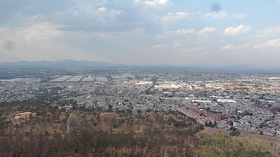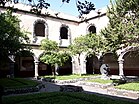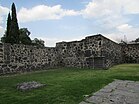
Back Iztapalapa AST Iztapalapa (munisipyo) CEB Iztapalapa German Iztapalapa Spanish Iztapalapa EU ایزتاپالاپا FA Iztapalapa French Iztapalapa GA Iztapalapa Hungarian Delegazione Iztapalapa Italian
Iztapalapa | |
|---|---|
|
Top: View of Iztapalapa from Cerro de la Estrella; Middle: Cerro de la Estrella National Park, San Matías Parish and Former Convent; Bottom: Cerro de la Estrella Archaeological Zone, Former Culhuacán Convent | |
 Iztapalapa within Mexico City | |
| Coordinates: 19°21′30″N 99°05′35″W / 19.35833°N 99.09306°W | |
| Country | Mexico |
| Federal entity | Mexico City |
| Established | 1928 |
| Named for | Ancient Aztec neighborhood |
| Seat | Aldama No. 63 esq. Ayuntamiento, Barrio San Lucas, Iztapalapa 09000 |
| Government | |
| • Mayor | Raúl Basulto Luviano (MORENA) |
| Area | |
• Total | 113.76 km2 (43.92 sq mi) |
| Elevation | 2,240 m (7,350 ft) |
| Population (2020).[1] | |
• Total | 1,835,486 |
| • Density | 16,000/km2 (42,000/sq mi) |
| Time zone | UTC-6 (Zona Centro) |
| Postal codes | 09000 – 09990 |
| Area code | 55 |
| HDI (2020) | |
| Website | [1] |
Iztapalapa (ⓘ) is a borough (demarcación territorial) in Mexico City, located on the eastern side of the city. The borough is named after and centered on the formerly independent municipality of Iztapalapa (officially Iztapalapa de Cuitláhuac). The rest is made up of a number of other communities which are governed by the city of Iztapalapa.
With a population of 1,835,486 as of 2020, Iztapalapa is the most populous borough of Mexico City and as well as the most populous municipality in the country. Over 90% of its territory is urbanized. The formerly rural borough, which was home to some farms and canals as late as the 1970s, to an area with its only greenery in parks; nearly all of its population employed in commerce, services and industry. This is the result of a large influx of people into the borough starting beginning in the 1970s, with the borough still attracting migrants.
Iztapalapa remains afflicted by high levels of economic deprivation, and a significant number of its residents lack access to clean drinking water. Iztapalapa has one of the highest rates of violent crime in Mexico City.[3][4] Combatting homicides and drug trafficking remain a major issue for local authorities.[5][6]
The borough is home of one of Mexico City's major cultural events, the annual Passion Play in which 450 borough residents participate and about 2 million attend as spectators.
- ^ a b c "Principales Resultados del Censo de Vivienda y Población 2020" (PDF) (in Spanish). Retrieved October 17, 2023.
- ^ "Base de datos del IDS-2020". Consejo de Evaluación de la Ciudad de México.
- ^ García, Jacobo (2021-10-18). "Iztapalapa: How Mexico City's most dangerous borough is breaking the stigma". EL PAÍS English. Retrieved 2024-07-03.
- ^ "Iztapalapa No. 1 of the 3 most dangerous boroughs in Mexico City". Mexico News Daily. 2019-06-14. Retrieved 2024-07-03.
- ^ Estevez, Dolia. "Rise In Criminal Violence In Mexico City May Be Linked To Drug Cartels". Forbes. Retrieved 2021-08-15.
- ^ "These Women Are The Only Reason Some People In Mexico City Get Any Water". BuzzFeed News. 22 February 2018. Retrieved 2021-08-15.





